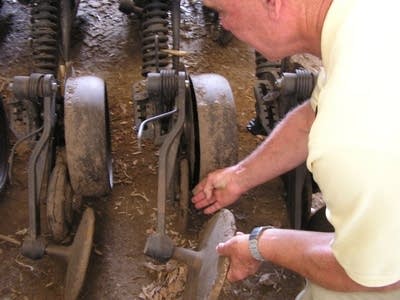Phosphorus strategy relies on good will
Go Deeper.
Create an account or log in to save stories.
Like this?
Thanks for liking this story! We have added it to a list of your favorite stories.

Phosphorus gets into the water a lot of ways: through storm water run-off, waste water discharge and the top soil skimmed off farm fields with rainfall. The Minnesota Pollution Control Agency is trying to limit the amount of phosphorus entering the states watershed. But it doesn't have the authority to limit phosphorous-based fertilizers on farm fields.
The Cannon River Watershed Partnership's Hillary Ziols is writing that watershed's pollution evaluation for the MPCA. She says a main source of phosphorus in her region is top soil washing off agricultural land.

"Many civilizations have been lost because they lost their topsoil," Ziols says. "And because they clogged their waterways with sediment," she says.
Ziols points to Palestine, once known as 'the Land of milk and honey,' and Lebanon as two examples. She says even if phosphorus input is reduced by 50 percent in parts of the Cannon River Watershed, there's no guarantee the watershed will recover.
Turn Up Your Support
MPR News helps you turn down the noise and build shared understanding. Turn up your support for this public resource and keep trusted journalism accessible to all.
In southeastern Minnesota Dave Legvold is a second generation farmer and the Cannon River Watershed Partnership's executive director.
Legvold walks along what's known as a no-till farm field. He says no-till is one way to reduce soil erosion. Tilling leaves the soil loose and vulnerable to erosion. Using no-till, growers' leave last year's crop residue and slice new seeds into the ground. Legvold pulls a dead corn stalk from the ground.
"So those roots are hanging onto the soil, and we have a good, robust healthy crop of soybeans coming up amidst old corn stubble," Legvold says.

Legvold also points where a field drains into a half acre of wetland, keeping sediment out of nearby streams.
Legvold practices this type of farming. He says he chose it because it's less time-intensive than plowing. He says every year his soil is healthier and needs less phosphorous-based fertilizer.
Legvold spends a lot of time talking to farmers about these types of systems. He says farmers often fear no-till will cut back on crop yield. He says farmers want to do what's environmentally sound, but they're hesitant to do something that might hurt their livelihood.
He says crop prices and federal subsidies are largely driving land management.
"The incentives to first of all produce maximum bushels, and farm maximum acres are driven by the dollar sign in the form of program payments, just sign up, farm the land and get a program payment," Legvold says.
Program payments are just one of several subsidies farmers get for production, he says. So his organization is offering its own payments. The Partnership offers incentives to install buffer strips and drainage systems that keep soil from getting into the waterways. But Legvold says a bigger help would be tying farm subsidies to conservation instead of production.

"And to be really blunt about it farmers can implement conservation practices more efficiently and more economically than almost any other sector," he says.
For example, he says, a farm can make changes to 100 acres of land that would reduce sediment by one half to two-thirds. He says that makes far more impact than what most municipalities could do.
State agencies are also promoting similar programs. The Natural Resource Conservation Service provides some grants for farmers to implement conservation practices. But all of this is voluntary. Representatives from the MPCA and the Department of Agriculture say that's a long-held decision made by the Legislature.
Representative Al Juhnke is the chair or the House Agricultural Committee. Juhnke says the Legislature doesn't mandate conservation practices because they're expensive for farmers. And he says no-till farming may be great for soil erosion, but it limits weed control. That may lead a farmer to use another chemical that's just as bad for the environment.

Juhnke says he would like the state Legislature to require conservation plans for all farms like they do in Iowa.
"Put together a conservation plan for their farm specific to their farm free of charge and obviously offer it to them and perhaps put some sort of incentive if they incorporate that plan into their farming operation," Juhnke explains.
Juhnke says money could come from sources like the Minnesota Clean Water Legacy Act, and concentrate on farms in areas with impaired waters. He believes this approach to conservation would be welcomed by both sides of the aisle.
Juhnke says he'll push for a bill in the next session as a way to balance high yields with cleaning up Minnesota's waters. But even this approach would be voluntary.





